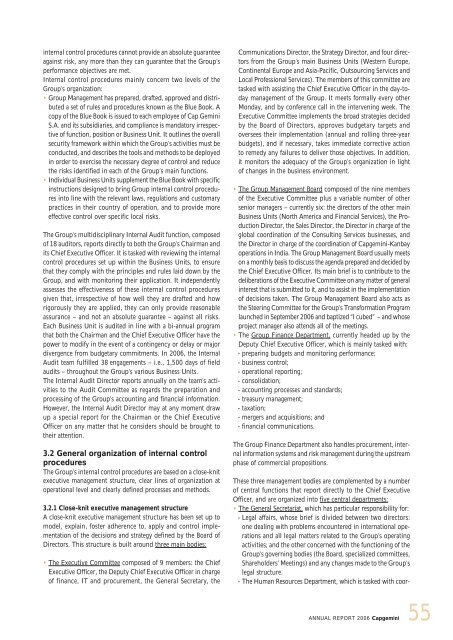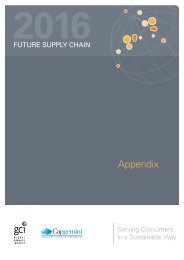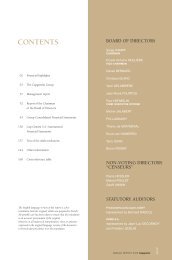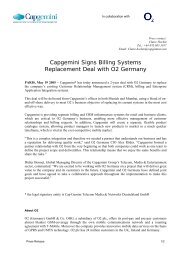You also want an ePaper? Increase the reach of your titles
YUMPU automatically turns print PDFs into web optimized ePapers that Google loves.
internal control procedures cannot provide an absolute guarantee<br />
against risk, any more than they can guarantee that the Group’s<br />
performance objectives are met.<br />
Internal control procedures mainly concern two levels of the<br />
Group’s organization:<br />
Group Management has prepared, drafted, approved and distributed<br />
a set of rules and procedures known as the Blue Book. A<br />
copy of the Blue Book is issued to each employee of Cap Gemini<br />
S.A. and its subsidiaries, and compliance is mandatory irrespective<br />
of function, position or Business Unit. It outlines the overall<br />
security framework within which the Group’s activities must be<br />
conducted, and describes the tools and methods to be deployed<br />
in order to exercise the necessary degree of control and reduce<br />
the risks identified in each of the Group’s main functions.<br />
Individual Business Units supplement the Blue Book with specific<br />
instructions designed to bring Group internal control procedures<br />
into line with the relevant laws, regulations and customary<br />
practices in their country of operation, and to provide more<br />
effective control over specific local risks.<br />
The Group’s multidisciplinary Internal Audit function, composed<br />
of 18 auditors, reports directly to both the Group’s Chairman and<br />
its Chief Executive Officer. It is tasked with reviewing the internal<br />
control procedures set up within the Business Units, to ensure<br />
that they comply with the principles and rules laid down by the<br />
Group, and with monitoring their application. It independently<br />
assesses the effectiveness of these internal control procedures<br />
given that, irrespective of how well they are drafted and how<br />
rigorously they are applied, they can only provide reasonable<br />
assurance – and not an absolute guarantee – against all risks.<br />
Each Business Unit is audited in line with a bi-annual program<br />
that both the Chairman and the Chief Executive Officer have the<br />
power to modify in the event of a contingency or delay or major<br />
divergence from budgetary commitments. In 2006, the Internal<br />
Audit team fulfilled 38 engagements – i.e., 1,500 days of field<br />
audits – throughout the Group’s various Business Units.<br />
The Internal Audit Director reports annually on the team’s activities<br />
to the Audit Committee as regards the preparation and<br />
processing of the Group’s accounting and financial information.<br />
However, the Internal Audit Director may at any moment draw<br />
up a special report for the Chairman or the Chief Executive<br />
Officer on any matter that he considers should be brought to<br />
their attention.<br />
3.2 General organization of internal control<br />
procedures<br />
The Group’s internal control procedures are based on a close-knit<br />
executive management structure, clear lines of organization at<br />
operational level and clearly defined processes and methods.<br />
3.2.1 Close-knit executive management structure<br />
A close-knit executive management structure has been set up to<br />
model, explain, foster adherence to, apply and control implementation<br />
of the decisions and strategy defined by the Board of<br />
Directors. This structure is built around three main bodies:<br />
The Executive Committee composed of 9 members: the Chief<br />
Executive Officer, the Deputy Chief Executive Officer in charge<br />
of finance, IT and procurement, the General Secretary, the<br />
Communications Director, the Strategy Director, and four directors<br />
from the Group’s main Business Units (Western Europe,<br />
Continental Europe and Asia-Pacific, Outsourcing Services and<br />
Local Professional Services). The members of this committee are<br />
tasked with assisting the Chief Executive Officer in the day-today<br />
management of the Group. It meets formally every other<br />
Monday, and by conference call in the intervening week. The<br />
Executive Committee implements the broad strategies decided<br />
by the Board of Directors, approves budgetary targets and<br />
oversees their implementation (annual and rolling three-year<br />
budgets), and if necessary, takes immediate corrective action<br />
to remedy any failures to deliver those objectives. In addition,<br />
it monitors the adequacy of the Group’s organization in light<br />
of changes in the business environment.<br />
The Group Management Board composed of the nine members<br />
of the Executive Committee plus a variable number of other<br />
senior managers – currently six: the directors of the other main<br />
Business Units (North America and Financial Services), the Production<br />
Director, the Sales Director, the Director in charge of the<br />
global coordination of the Consulting Services businesses, and<br />
the Director in charge of the coordination of <strong>Capgemini</strong>-Kanbay<br />
operations in India. The Group Management Board usually meets<br />
on a monthly basis to discuss the agenda prepared and decided by<br />
the Chief Executive Officer. Its main brief is to contribute to the<br />
deliberations of the Executive Committee on any matter of general<br />
interest that is submitted to it, and to assist in the implementation<br />
of decisions taken. The Group Management Board also acts as<br />
the Steering Committee for the Group’s Transformation Program<br />
launched in September 2006 and baptized “I cubed” – and whose<br />
project manager also attends all of the meetings.<br />
The Group Finance Department, currently headed up by the<br />
Deputy Chief Executive Officer, which is mainly tasked with:<br />
- preparing budgets and monitoring performance;<br />
- business control;<br />
- operational reporting;<br />
- consolidation;<br />
- accounting processes and standards;<br />
- treasury management;<br />
- taxation;<br />
- mergers and acquisitions; and<br />
- financial communications.<br />
The Group Finance Department also handles procurement, internal<br />
information systems and risk management during the upstream<br />
phase of commercial propositions.<br />
These three management bodies are complemented by a number<br />
of central functions that report directly to the Chief Executive<br />
Officer, and are organized into five central departments:<br />
The General Secretariat, which has particular responsibility for:<br />
- Legal affairs, whose brief is divided between two directors:<br />
one dealing with problems encountered in international operations<br />
and all legal matters related to the Group’s operating<br />
activities; and the other concerned with the functioning of the<br />
Group’s governing bodies (the Board, specialized committees,<br />
Shareholders’ Meetings) and any changes made to the Group’s<br />
legal structure.<br />
- The Human Resources Department, which is tasked with coor-<br />
ANNUAL REPORT 2006 <strong>Capgemini</strong><br />
55















